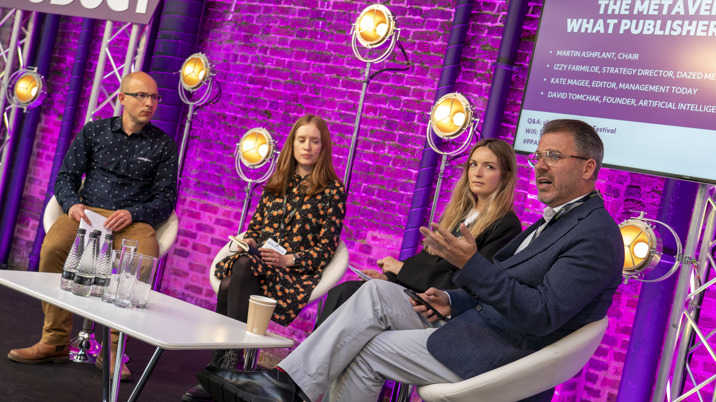
The term ‘metaverse’ dates back to the 1970s but only passed into common currency this year. That’s thanks to Facebook’s rebranding as Meta, often seen in the tech world as a move to detract attention away from Facebook’s ethical issues and its ageing user base. But it’s how most people first heard of the metaverse.
Like many other magazines, E&T used the term for the first time on its cover this year, but we’ve been reporting on the enabling technologies for years, ranging from virtual and augmented reality to haptic interfaces and low-latency communications. Economies needs scarcity. In the digital world, that’s tricky because digital products are so easily and cheaply copied. Non-Fungible Tokens, or NFTs, artificially create that scarcity, which is why it’s seen as underpinning the metaverse.
The metaverse vision is one of a connected, immersive and, of course, interactive virtual world – rather like a textured, 3D world wide web.
If this sounds familiar, you may be remembering Second Life, an earlier incarnation of a virtual world. It created a buzz nearly twenty years ago, way back in 2003. By now, we should all be living alternative escapist lives as avatars – better looking, more exciting versions of our dull real selves.
It too was hugely hyped and it too attracted a lot of interest. Publishers from Reuters to MSN employed journalists to report from the virtual world. But it turned out there wasn’t much to report. Our own journalist at the time said in Second Life he mainly met other journalists wandering around cyberspace in search of genuine participants.
Second Life is still going. This year, we sent a reporter back there to find it’s now something of a ghost town populated, at best, by people more comfortable in pixels than real life. The public think it’s all about sex; a quarter to a third of it is. And a professor told her: “We would try to have very serious lectures and people would bomb all attendees with flying penises.” In fact, the ‘time to penis’ metric is well-known to virtual world developers.
Twenty years after the launch of Second Life, the media is already turning up the catfishing and the grooming stories from the fledgling metaverse. Whether it’s home video, the worldwide web or even the printed novel, every new media brings fears and dangers – sometimes exaggerated, but often real and persistent. This is the latest, but it’s not that new and tomorrow’s builders of virtual worlds need to learn the lessons of yesterday’s mistakes.
The publishing dimension
The metaverse is in its early days, with many as yet unresolved technical questions. Is it overhyped right now? Probably, yes, agreed the panel but it is coming and publishers should consider their place in it. We heard how Management Today had rented some metaverse space to build a front cover two stories high, pointing to its online page-turner of the issue, and snapped that virtual edifice for its real front page. It was a clever approach to its metaverse coverage but seemed to be led by print and used a media of the future to point readers to a 20th century media.
Dazed shot Rihanna in a spliff costume for their cover and put up the NFT version as a competition prize. Other magazines have done similar NFT covers or issues. Time reckons it was the first to release a whole issue as an NFT.
But NFTs have now been used to authenticate everything from Jack Dorsey’s first tweet to toilet paper to perfume. Every day, I receive another press release about another NFT first and it’s beginning to look like a fad if not a bubble. I can see that an NFT on digital art adds value of authentication in the same way as an artist’s signature on a limited edition silk screen print. But it’s hard to see the intrinsic value of many others, and they are now fetching crazy prices as investments.
It’s good to be experimenting in the metaverse, especially if you have a young readership because the metaverse community is very young. But so far, it’s hard to see how it will work for publishers. It is still a long way off. Gartner reckons one in four people will spend an hour a day in the metaverse by 2026 but it puts the trend outside its 8-year time frame for emerging technologies.
Our technology journalists were more excited by the metaverse’s less discussed work opportunities than the hyped leisure opportunities. We often hear about the importance of new technology described in consumer terms because it’s easier to relate to what it will mean for our home life, shopping habits or social life than how it will change factories, schools, hospitals or even offices. Yet, it’s in our working life that we have first encountered some of the most important technology shifts.
We’ve all got used to working in Zoom or Teams now and the metaverse promises to take that to a whole new level: digital twin products brought to the board room table, staff taken to a virtual version of their factory, or 3D avatars collaborating on a new idea with animated visuals. It would be a welcome break from the home desk and the flat screen.
Publishing is still feeling the effects of the first wave of the web, followed by social media. If it does live up to the hype, the metaverse will mean even more digital distraction, making it more of a threat than an opportunity. Let’s hope I’m wrong.
This article was first published in InPublishing magazine. If you would like to be added to the free mailing list, please register here.












